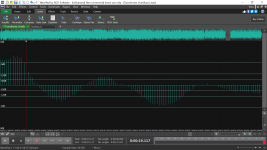Even though A+ passes through the output transformer, if no tubes are installed, no current should be flowing... unless, there is leakage current. Capacitive coupling between windings and transformer core could be an issue. Insulation breakdown is another source of leakage. The waveform looks like diode related switch noise.
With the tubes removed, and 8 Ohm loads on the output transformer taps, how much 50Hz hum is there _______ mV?
With all the tubes installed, the inputs shorted, and 8 Ohm loads on the output transformer taps, how much 50Hz hum is there ______ mV?
I do not know that scope. It does say, H 5ms. is that 5ms/division?
From your scope screen capture in Post # 12, at 5msec/division, the main (biggest positive pulses) are 2 divisions, 10ms apart. 1/0.010 sec = 100Hz
Or is that 20ms/division? 1/40ms = 25Hz.
Or is that 10ms/division 1/20ms = 50 Hz.
The readouts are not intuitive for me.
There are other smaller pulses in between.
Was the scope trace taken with the output loaded by an 8 Ohm load resistor?
Or were the outputs unloaded?
Were the tubes in or out of the amplifier?
Is there a power mains ground loop from the scope ground to the amplifier ground, that is causing the apparent ripple.
If there is ground current from the scope probe ground clip to the amplifier ground, that 'effectivly' creates an apparent signal into the probe / scope measurement.
In that case, you are measuring the voltage of the ground loop.
With all the tubes installed, the inputs shorted, and 8 Ohm loads on the output transformer taps, how much 50Hz hum is there ______ mV?
I do not know that scope. It does say, H 5ms. is that 5ms/division?
From your scope screen capture in Post # 12, at 5msec/division, the main (biggest positive pulses) are 2 divisions, 10ms apart. 1/0.010 sec = 100Hz
Or is that 20ms/division? 1/40ms = 25Hz.
Or is that 10ms/division 1/20ms = 50 Hz.
The readouts are not intuitive for me.
There are other smaller pulses in between.
Was the scope trace taken with the output loaded by an 8 Ohm load resistor?
Or were the outputs unloaded?
Were the tubes in or out of the amplifier?
Is there a power mains ground loop from the scope ground to the amplifier ground, that is causing the apparent ripple.
If there is ground current from the scope probe ground clip to the amplifier ground, that 'effectivly' creates an apparent signal into the probe / scope measurement.
In that case, you are measuring the voltage of the ground loop.
Last edited:
50Hz hum if it is 50Hz like you are saying, is AC before rectification. So I would check the mains wiring going to the on off switch as it look like it runs along the OPT secondary wire to the speaker terminal at the back of the chassis.
I'm afraid it's looking more and more like a broken mains transformer.
I've replaced all the diodes and still a nasty hum and rattling/crackling sound comes from the transformer.
I've replaced all the diodes and still a nasty hum and rattling/crackling sound comes from the transformer.
That’s bad news. With nothing attached the transformer should be quiet and drawing only minimal current. Do you still have a secondary voltage? Is it instable? Have you tried loading the secondary with 2 light bulbs of 230 V in series to check stability? I usually try with 50 Watt halogen bulbs in series, but the load depends on the transformer of course.
Regards, Gerrit
Regards, Gerrit
Why not measure the voltage across each 220K voltage divider in capacitor stack in A+? You should get equal voltage (910/4=227.5). Any weakness in cap or resistor would show up.
Also why not disconnect the entire cap stack so now it's really nothing is connected, see if still have mechanical rattling?
OR simply disconnect A+ to OT, see hum still audible?
Also why not disconnect the entire cap stack so now it's really nothing is connected, see if still have mechanical rattling?
OR simply disconnect A+ to OT, see hum still audible?
Last edited:
Whenever you remove tubes from an amplifier, and power the amplifier on,
The DC high voltage increases (no load).
That will test whether the electrolytic voltage ratings are high enough, versus the unloaded DC voltage.
Just a word of caution.
The DC high voltage increases (no load).
That will test whether the electrolytic voltage ratings are high enough, versus the unloaded DC voltage.
Just a word of caution.
Here's a audio recording with a mic (akg c414) above the power transformer.
Just to recap:
- all the tubes have been replaced by new ones
- all the capacitors have been replaced and measure ok
- voltages in the amp are ok (according to the technician at Ming-Da)
- the hum/noise coming from the transformer doesn't sound like mechanical noise, more 'electric' noise
- the same hum is coming from the speakers.
In the audio file you can hear the hum getting louder once the speakers are engaged (there's a timer-relay in there).
Just to recap:
- all the tubes have been replaced by new ones
- all the capacitors have been replaced and measure ok
- voltages in the amp are ok (according to the technician at Ming-Da)
- the hum/noise coming from the transformer doesn't sound like mechanical noise, more 'electric' noise
- the same hum is coming from the speakers.
In the audio file you can hear the hum getting louder once the speakers are engaged (there's a timer-relay in there).
Attachments
Last edited:
Too many secondaries, with solid state rectifiers, driving too many uF, and the only series resistances is the multiple secondary windings DCRs, and the primary windings DCR.
I bet the transformer is saying: "Ugg!" heavy transient currents . . . all at the same time. Mechanical Hum.
And that many different supplies, means there are more candidates for possible hum ground loops to inject electrically, or magnetically into sensitive grid circuits.
The rectifiers are mostly full wave (2X power mains frequency), but the primary is at 1X the power mains frequency.
True "Electrical" noise from a transformer is likely arcing.
Is that a high quality power transformer?
Is it under-rated versus the way it is being used?
I bet the transformer is saying: "Ugg!" heavy transient currents . . . all at the same time. Mechanical Hum.
And that many different supplies, means there are more candidates for possible hum ground loops to inject electrically, or magnetically into sensitive grid circuits.
The rectifiers are mostly full wave (2X power mains frequency), but the primary is at 1X the power mains frequency.
True "Electrical" noise from a transformer is likely arcing.
Is that a high quality power transformer?
Is it under-rated versus the way it is being used?
Last edited:
That’s a lot of hum and rattling noise. It sounds like some kind of intermittent contact inside the transformer. If this is the case I would expect some instability in the output voltage.
I’ve had sparkling cables sounding somewhat similar.
Regards, Gerrit
I’ve had sparkling cables sounding somewhat similar.
Regards, Gerrit
Could also be magnetostrsiction of the transformer housing.. Magnetic flux leakage is moving the diaphragm that is the transformer housing.. Does this product have a grounded/earthed mains plug? If yes, can you "float" or lift the ground/earth connection? If yes, do you measure any voltage between the chassis and ground/earth. If you do get a voltage that is higher than a few volts, can you measure the current? This will give you a good indication if the transformer insulation is failing and or capacitively coupling to the core or housing.
I'll give it a try tomorrow. I've tested it a while ago with an army surplus mains isolation transformer which had no mains ground. Situation was the same but didn't do any measurements.
Yes, I'm not a big fan of groundless mains, especially with voltages of 900+..
One thing to note is that all the metal screws in the amp were covered in rust. The owner lives on a houseboat although it was years in storage somewhere else.
One thing to note is that all the metal screws in the amp were covered in rust. The owner lives on a houseboat although it was years in storage somewhere else.
Now, that is an important fact that might have been nice to know in Post # 1.
Anybody, care to give some new input on the cause of the listed problems?
Anybody, care to give some new input on the cause of the listed problems?
True, but this only became clear after removing the transformer enclosure. All the other stuff that looked like rust turned out to be dried out glue.
Maybe moisture has been building up inside the transformer housing and gotten between the layers?
Maybe moisture has been building up inside the transformer housing and gotten between the layers?
Do you mean a separate cover (enclosure)?
Is that a magnetic cover? Attracted to the power transformer's magnetic fields?
How about a transformers outer layer windings that are high voltage, and are unshielded?
When rusty things vibrate (poor electrical connection), we may have some electrical interference too (a poorly connected/intermittently connected shield).
Is that a magnetic cover? Attracted to the power transformer's magnetic fields?
How about a transformers outer layer windings that are high voltage, and are unshielded?
When rusty things vibrate (poor electrical connection), we may have some electrical interference too (a poorly connected/intermittently connected shield).
Or its present in whatever device made the recording.. Making a digital recording of a very analog noise in a tube amp... hmm... Anyone see some inconsistencies here? 😉
- Home
- Amplifiers
- Tubes / Valves
- Ming-da MC3008-AB hum problem

